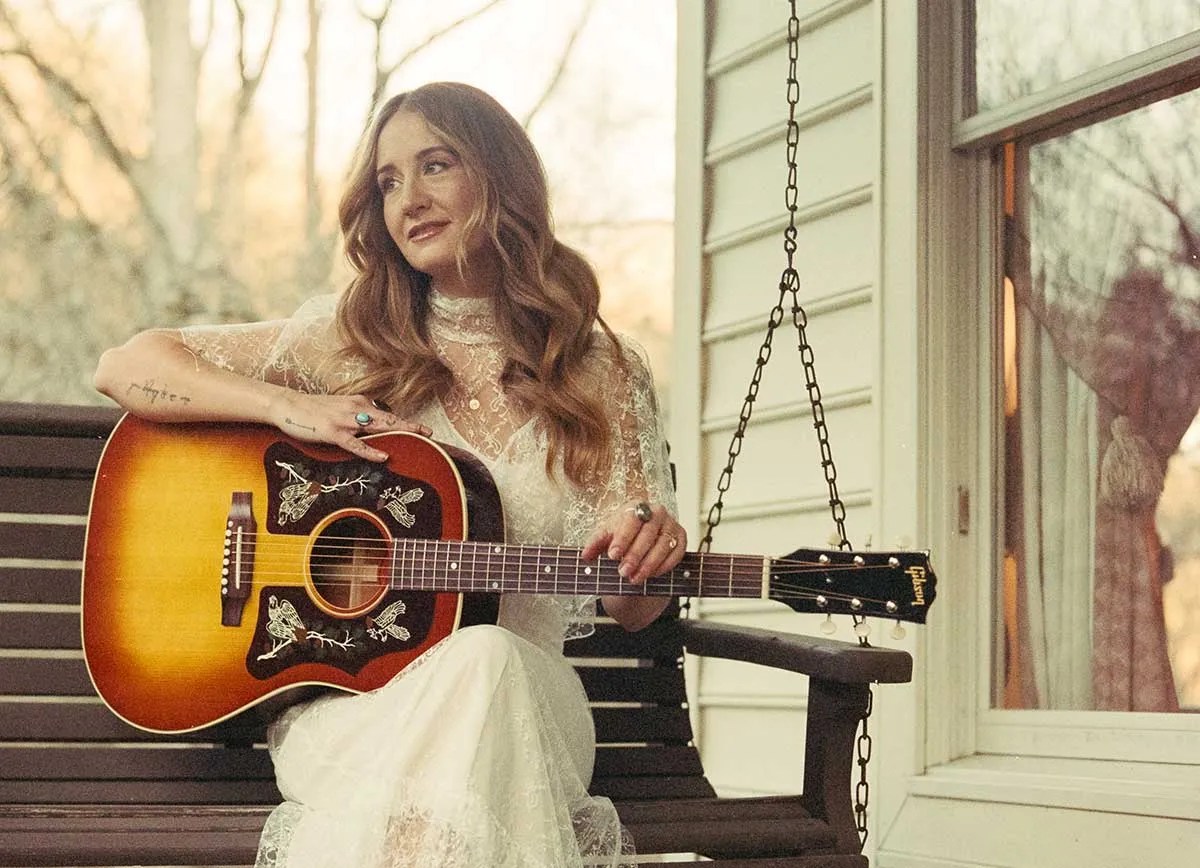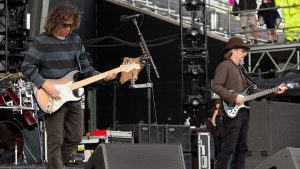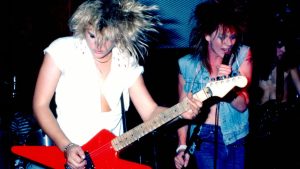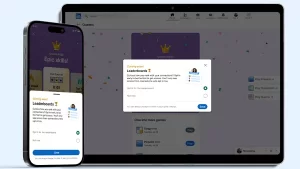
Americana Champion Margo Price Takes Flight with Her New Signature Gibson J-45
Margo Price’s signature Gibson J-45 is framed by twin pickguards inlaid with a quartet of red-tailed hawks—a nod to Gibson’s classic motifs of hummingbirds and doves and a mark of Price’s own distinctive spirit. But for Price, those hawks run deeper: over the last decade she’s carved out a singular space in modern Americana with sharp, soul-baring songwriting, fierce independence, and vintage-informed roots sensibilities.
“Driving back and forth from Nashville to my folks’ place in Illinois, I would see these beautiful red-tailed hawks, and I always found a lot of wisdom and resilience in them,” explains Price, 42, a Tennessee resident for decades now. “They’re watchers; they’re looking out for us, and we sure need that now.” It’s perhaps no coincidence that the hawks are said to be the protector spirits of the Cherokee Nation, divine messengers that carry the news of dreams realized, or as Price puts it, “messages of strength and perseverance.”
Perseverance has led Price to the career landmark of a Gibson J-45 with her name on it, the hardscrabble work that took place even before her breakout debut, Midwest Farmer’s Daughter (released under Jack White’s Third Man imprint in 2016), earned her the 2017 American Music Prize for Best Debut Album. Since then, she’s received Grammy nominations, appeared on Saturday Night Live, become a staple at the historic Ryman Auditorium, and hit the road with the Tedeschi Trucks Band, Tyler Childers, Willie Nelson, and more. Her narrative of vulnerable defiance, rooted in her rural upbringing, was crystallized in “Hands of Time,” the mid-century-style country ballad released in 2016 that became her signature song—a thread she continues to explore on her latest album, Hard Headed Woman.
I recently sat down with Margo Price at the Gibson Garage in Nashville during the unveiling of her new signature J-45 to talk about her bond with her instruments, her songwriting philosophy, and more.
Finding the One“My first guitar was a Samick,” recalls Price, “and after that I begged my folks for a Takamine. Eventually I’d find my great-uncle’s mid-’50s Gibson LG-3 in my grandmother’s closet, in very bad shape, with its neck snapped off.” Price’s great-uncle? None other than veteran Nashville songwriter Bobby Fischer, who’s penned hit songs for everyone from Charlie Pride to George Jones to Reba McEntire. Perhaps Fischer’s magic rubbed off. Once Price had the old LG-3 repaired, it became her central learning, songwriting, and performance tool—until an advance on her first album gave her the means to find her Excalibur.
“I walked into Carter’s Vintage Guitars here in Nashville,” Price explains. “I went in with a very open mind—I tried Gibsons, Martins, and Taylors, but when I picked up that mid-’60s Gibson J-45 I immediately loved the size of it, the sound, and the feeling of it. I didn’t want to put it down. OK, I couldn’t put it down!”
The guitar quickly became Price’s main ax for writing, recording and performing. Price had a K&K Sound Double Helix pickup installed in it for live shows, and hasn’t looked back since. “It’s my main baby, the guitar I play all the time.”
Designing the Signature ModelWith Price’s increasingly high profile, her J-45 began to enter public consciousness as well. A signature version was imminent. Enter Gibson’s acoustic guitar guru Robi Johns, who helped Price produce a personalized take on her beloved J-45, with changes like a narrower waist, a red spruce top, and built-in L.R. Baggs VTC electronics. The guitar’s elaborate dual pickguard, above and below the soundhole, which evokes the design of models like the Gibson Everly Brothers J-180, is stunning, but as Price explains, it’s not just for show.
“You’ll notice that my longtime J-45 has a huge amount of wear on the body, especially the area above the soundhole,” she explains, “because I strum pretty hard right there. So the dual pickguards weren’t just about aesthetics. Yes, I love the way they look, but I really wanted my signature model to have that extra protection, because it’s such a nice guitar.”
Likewise, the rich cherry sunburst finish—noticeably more vibrant than that on her old J-45—was anything but a random choice, nor were the red-tailed hawks who adorn the pickguard. As Price explains, “Red, as a color, relates to matters of the heart, but if you look closely, the ends of the hawks’ feathers are dipped in white, and the birds have a distinctly spiritual nature to them. When I’m on long road trips, they pass over me at the most kismet times, reminding me to find strength in my vulnerability and to open up and connect to those around me. I hope this guitar will remind those who play it of these lessons as well.”
Sketches and NotebooksPrice, a prolific writer who draws from a deep well of reference points, calls herself a believer in the idea that “if you can’t remember the melody, you have to ask yourself if it’s worth going back to.” Songs like “Since You Put Me Down,” from her 2016 debut, and the lovely acoustic tune “Lydia” from 2023’s Strays, contain more than their share of indelible phrases.
Whether fingerpicked or played with a pick, Price’s acoustic parts are the pillar of both the architecture and the groove of her songs. Even in concert, and on tracks with electric guitars and drums, her chordal work, with its hammer-ons and ornamentation, is central.
Her inner game of songwriting is an open-ended one, she says, part of her art of living. Ideas can come from everywhere, at any time. Price says, “If I’m talking to someone and they say something funny or interesting, I’ll jot that down. Or ideas can come from being with the band, standing over by the drums, or when my husband [guitarist and songwriter Jeremy Ivey] has a guitar idea I can bounce off. Sometimes it’s just a scrap of melody that comes to me. The best songs arrive like lightning: you get the whole theme of the song all at once. Others require a lot more wrestling.”
These days, Price documents her budding song ideas with the Audigo portable wireless microphone and recording app for iOS [see review in the November/December 2024 issue], with its pleasing stereo spread. “The Audigo sounds great,” Price says, “and on your iPhone you can add reverb, EQ, compression, and delay to tailor the sound a bit more.” Pretty modern stuff, though Price confesses that her lyric-writing process depends on more, shall we say, antiquated technology. “Yeah,” she laughs, “I still like to write my lyrics down in a good ol’ fashioned notebook. So, call me old school.”











